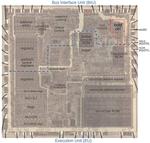Other

“In 1979, Intel introduced the 8088 microprocessor, a variant of the 16-bit 8086 processor. IBM’s decision to use the 8088 processor in the IBM PC (1981) was a critical point in computer history, leading to the success of the …

“When I look inside a chip from the popular 7400 series, I know what to expect: a fairly simple die, implemented in a straightforward, cost-effective way. However, when I looked inside a military-grade chip built by Integrated Device Technology (IDT …

“In 1979, Intel introduced the 8088 microprocessor, a variant of the 16-bit 8086 processor. IBM’s decision to use the 8088 processor in the IBM PC (1981) was a critical point in computer history, leading to the dominance of the …

“The 386 processor (1985) was Intel’s most complex processor at the time, with 285,000 transistors. Intel had scheduled 50 person-years to design the processor, but it was falling behind schedule. The design team decided to automate chunks of …

“Processors are driven by a clock, which controls the timing of each step inside the chip. In this blog post, I’ll examine the clock-generation circuitry inside the Intel 386 processor. Earlier processors such as the 8086 (1978) were simpler …

“The groundbreaking Intel 386 processor (1985) was the first 32-bit processor in the x86 line. It has numerous internal registers: general-purpose registers, index registers, segment selectors, and more specialized registers. In this blog post, I look at the silicon die …
“You might think of the Intel 386 processor (1985) as just an early processor in the x86 line, but the 386 was a critical turning point for modern computing in several ways.1 First, the 386 moved the x86 architecture …

“A key concept for a processor is the management of “state”, information that persists over time. Much of a computer is built from logic gates, such as NAND or NOR gates, but logic gates have no notion of time. Processors …

“The Intel 8086 processor started the x86 architecture that is still extensively used today. The 8086 has some quirky characteristics: it is little-endian, has a parity flag, and uses explicit I/O instructions instead of just memory-mapped I/O. It …

“The Intel 8086 microprocessor (1978) revolutionized computing by founding the x86 architecture that continues to this day. One of the lesser-known features of the 8086 is the “hold” functionality, which allows an external device to temporarily take control of the …

